Topic 14: Reproduction in Plants
1/52
Earn XP
Description and Tags
Remember to Watch & Read the Investigation of Germination!
Name | Mastery | Learn | Test | Matching | Spaced |
|---|
No study sessions yet.
53 Terms
What is sexual reproduction?
A process involving the fusion of the nuclei of two gametes to form a zygote and the production of offspring that are genetically different from each other.
What is asexual reproduction?
A process resulting in the production of genetically identical offspring from one parent.
What is fertilization?
The fusion of the nuclei of gametes.
The nuclei of gametes are…?
Haploid, meaning they contain one set of chromosomes.
The nucleus of a zygote is…?
Diploid, meaning it contains two sets of chromosomes — one from each parent.
What are the advantages of asexual reproduction for a population of species in the wild?
Only one parent is needed, faster reproduction, useful in stable environments, can quickly colonize an area, and offspring can be well adapted to the environment & grow well.
What are the advantages of sexual reproduction for a population of species in the wild?
Their offspring has genetic variation, increases their chance of survival in change of environment or against new diseases, can be dispersed over a wide area so they can colonize new areas, and enables natural selection and evolution.
What are the disadvantages of asexual reproduction for a population of species in the wild?
Offspring has no genetic variation, they are more vulnerable to diseases or environmental changes, and can lead to overcrowding and competition.
What are the disadvantages of sexual reproduction for a population of species in the wild?
It requires two parents, its slower than asexual reproduction, takes time & energy to find mates, and its difficult for isolated members of the species to reproduce.
What are the advantages of asexual reproduction for crop production?
Desirable traits (e.g. size, taste) are passed on exactly to their offspring, ensures uniform crops for harvesting and commercial sale, and it's faster and cheaper than growing from seed.
What are the advantages of sexual reproduction for crop production?
Genetic variation can lead to improved traits (e.g. disease resistance, higher yield), enables selective breeding, produces new varieties of plants, and helps crops adapt to new environmental changes.
What are the disadvantages of asexual reproduction for crop production?
All plants are genetically identical, so one disease can kill all, there are no improvements in traits over time, and may reduce biodiversity in crops
What are the disadvantages of sexual reproduction for crop production?
Takes longer than asexual reproduction, traits are not always predictable, more resources (space, labor, time) needed for growing from seeds, and may be less successful than the parent plant at growing well or producing a good harvest.
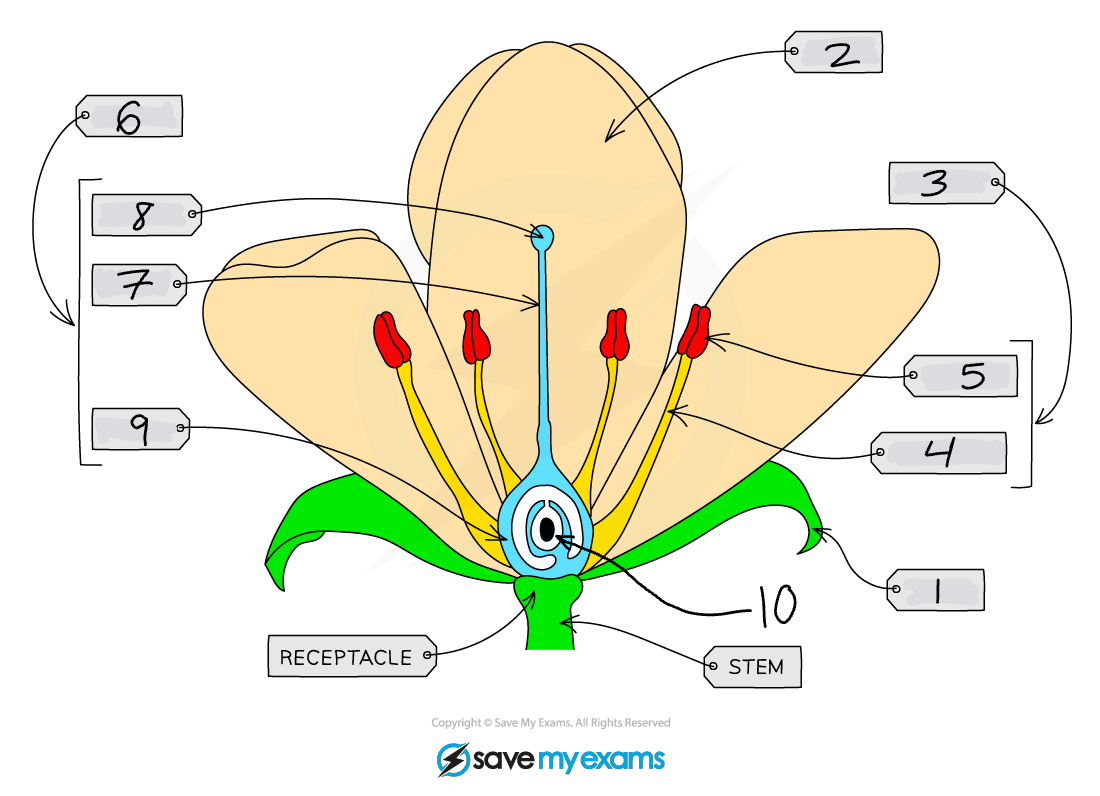
What is 1?
Sepals
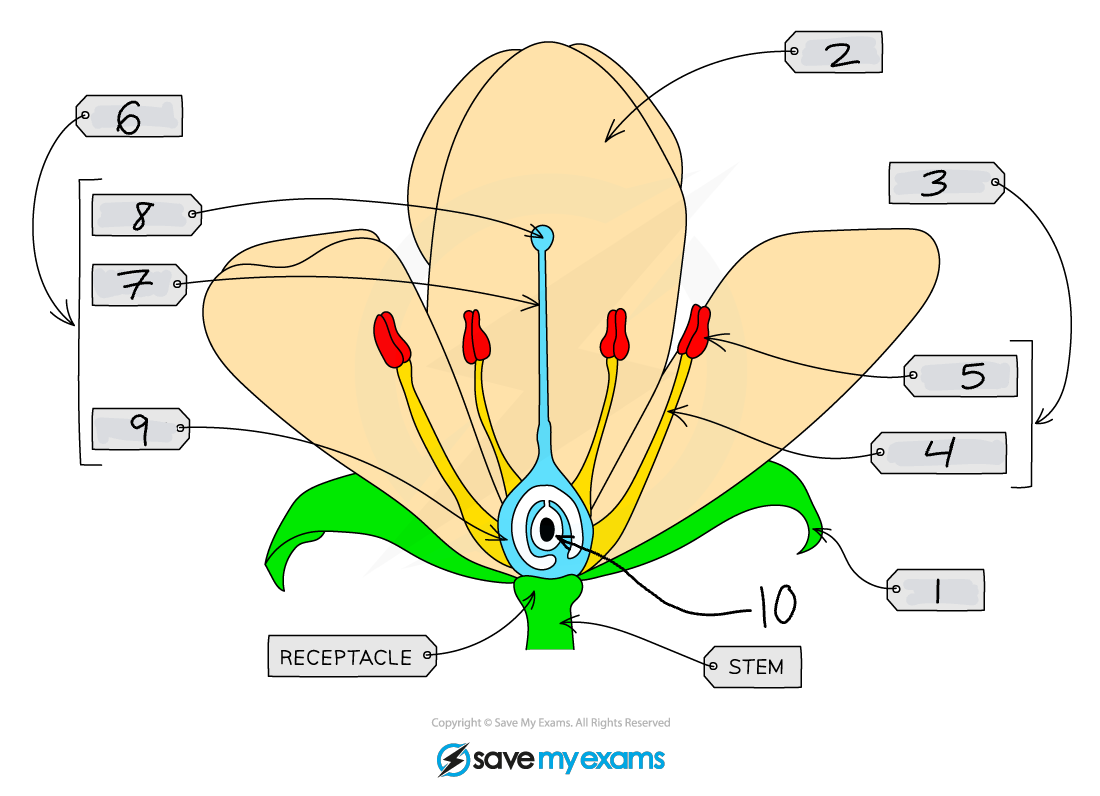
What is 2?
Petals
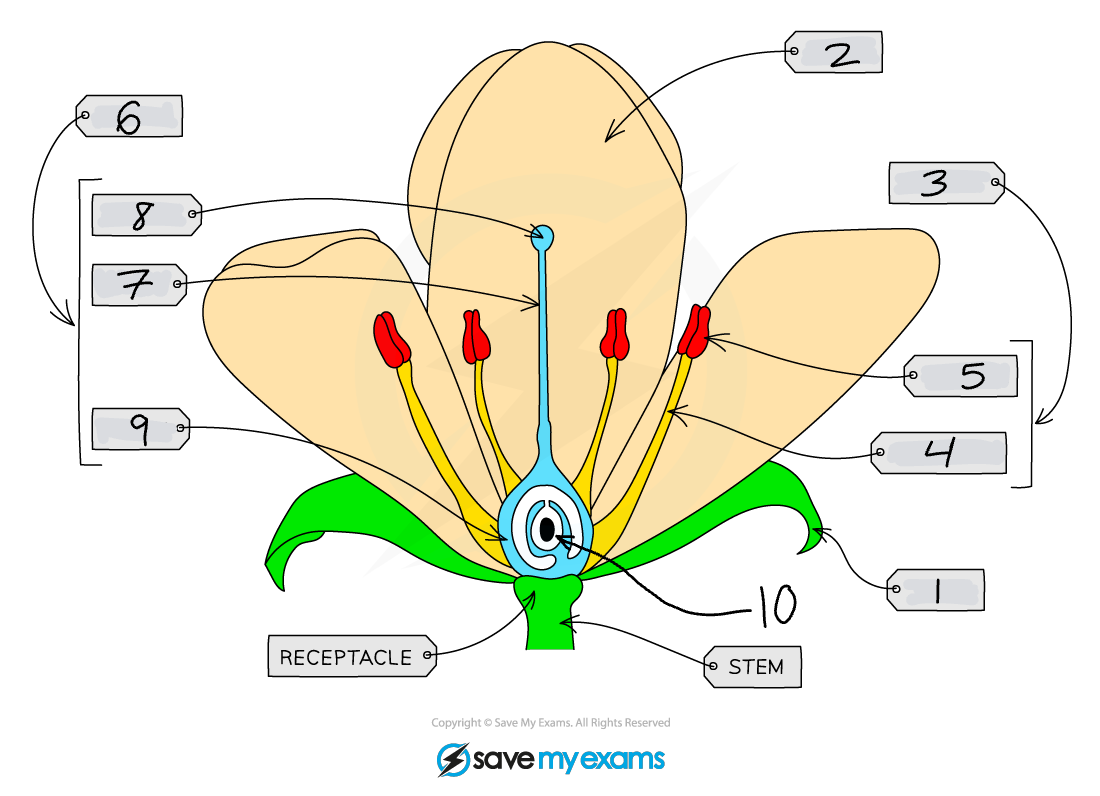
What is 3?
Stamens
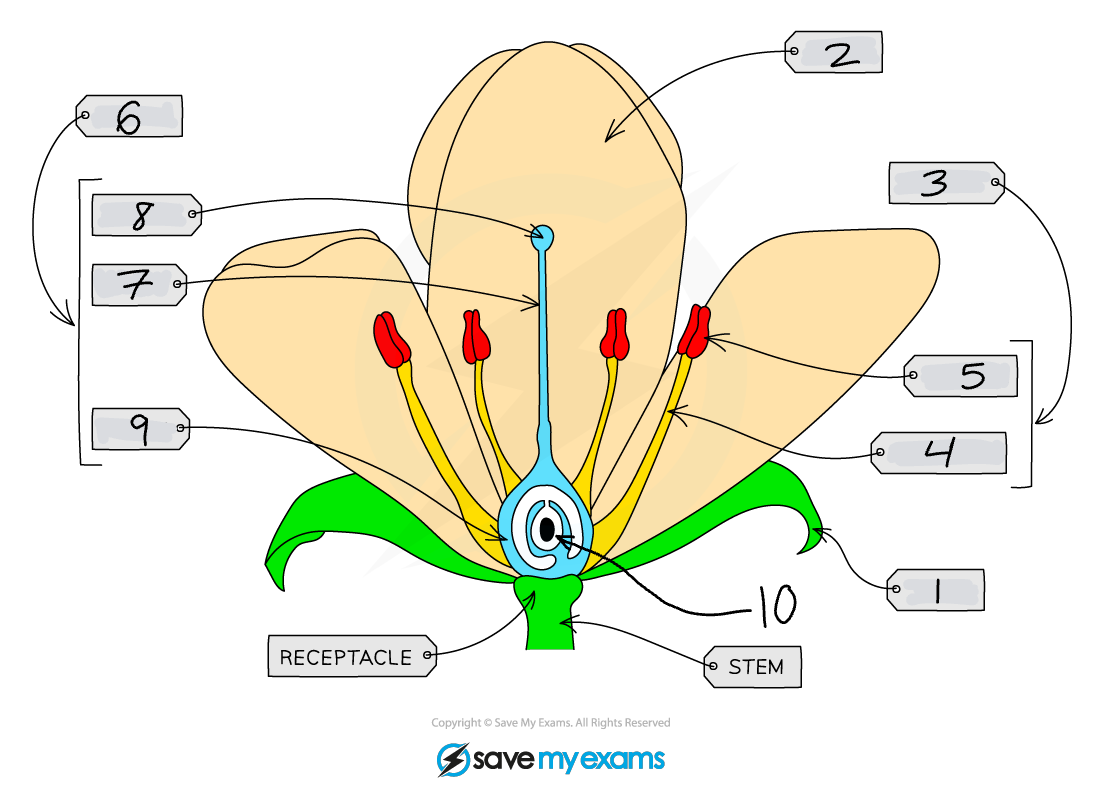
What is 4?
Filaments
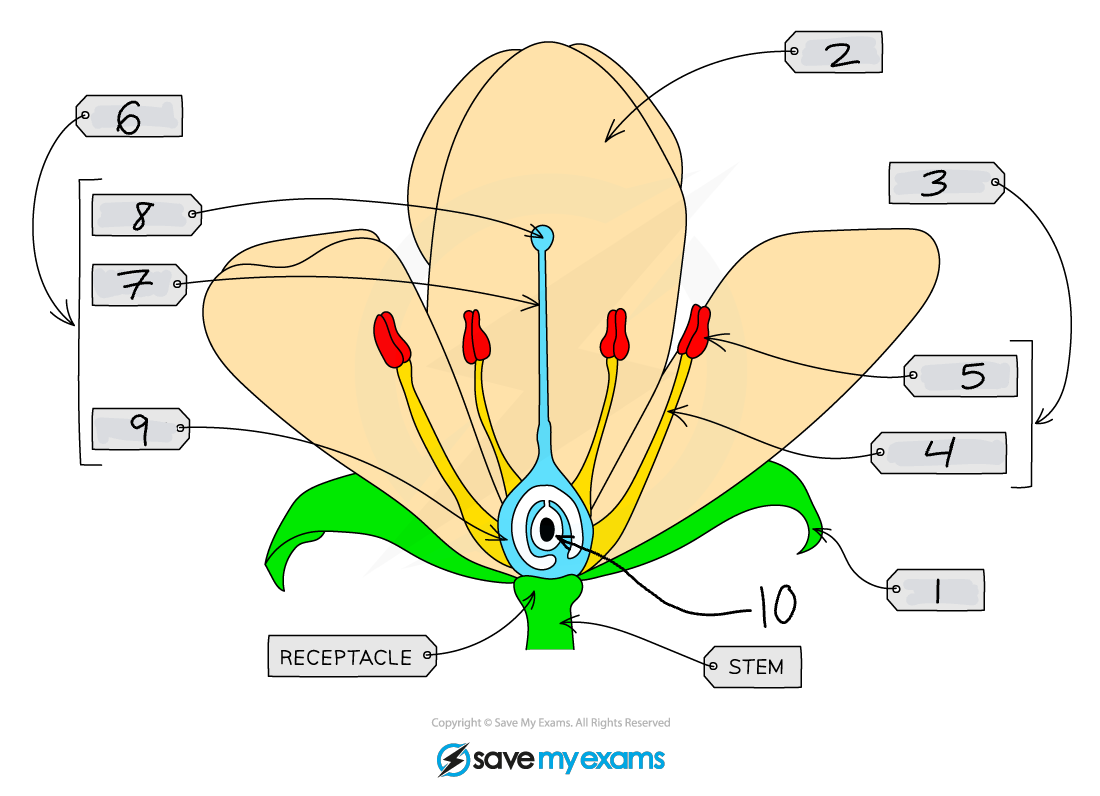
What is 5?
Anthers
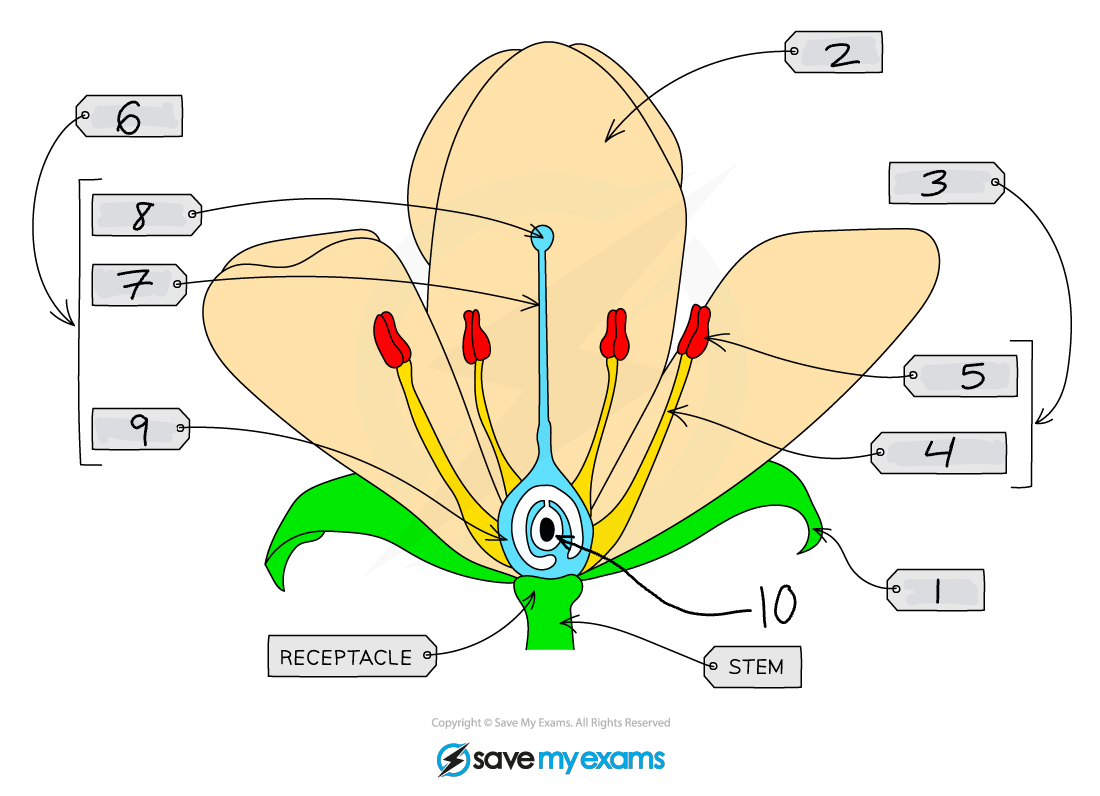
What is 6?
Carpels
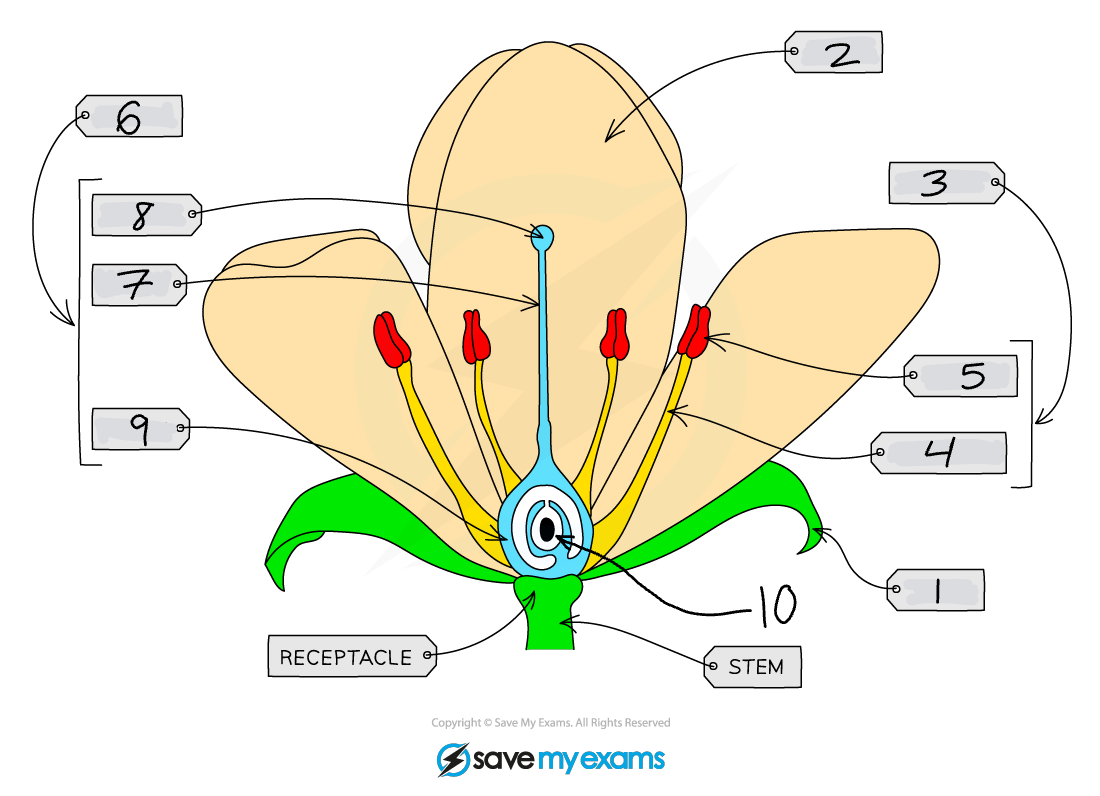
What is 7?
Style
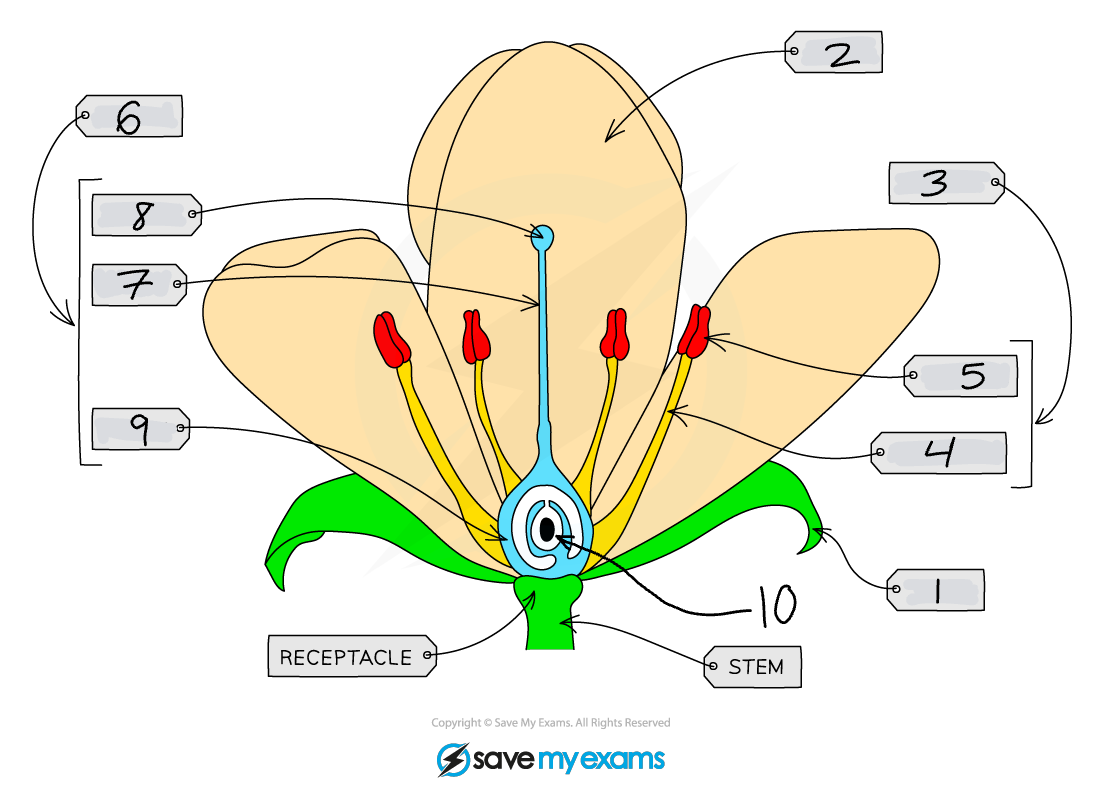
What is 8?
Stigma
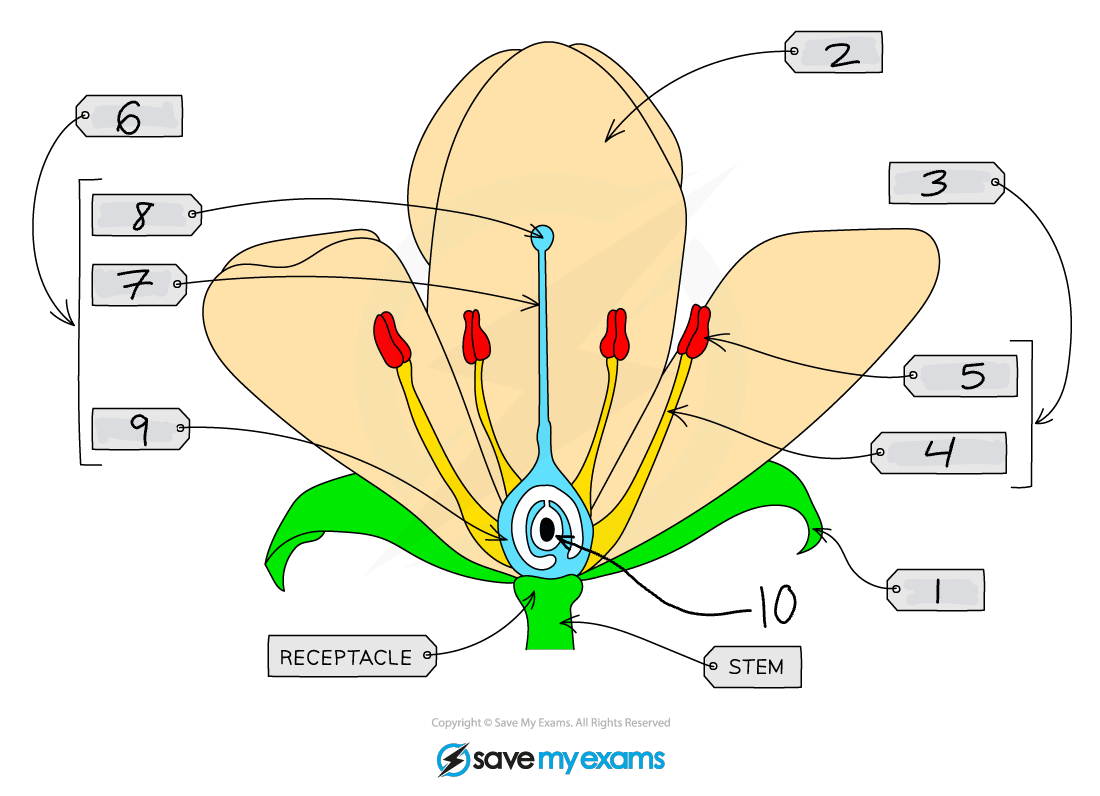
What is 9?
Ovary
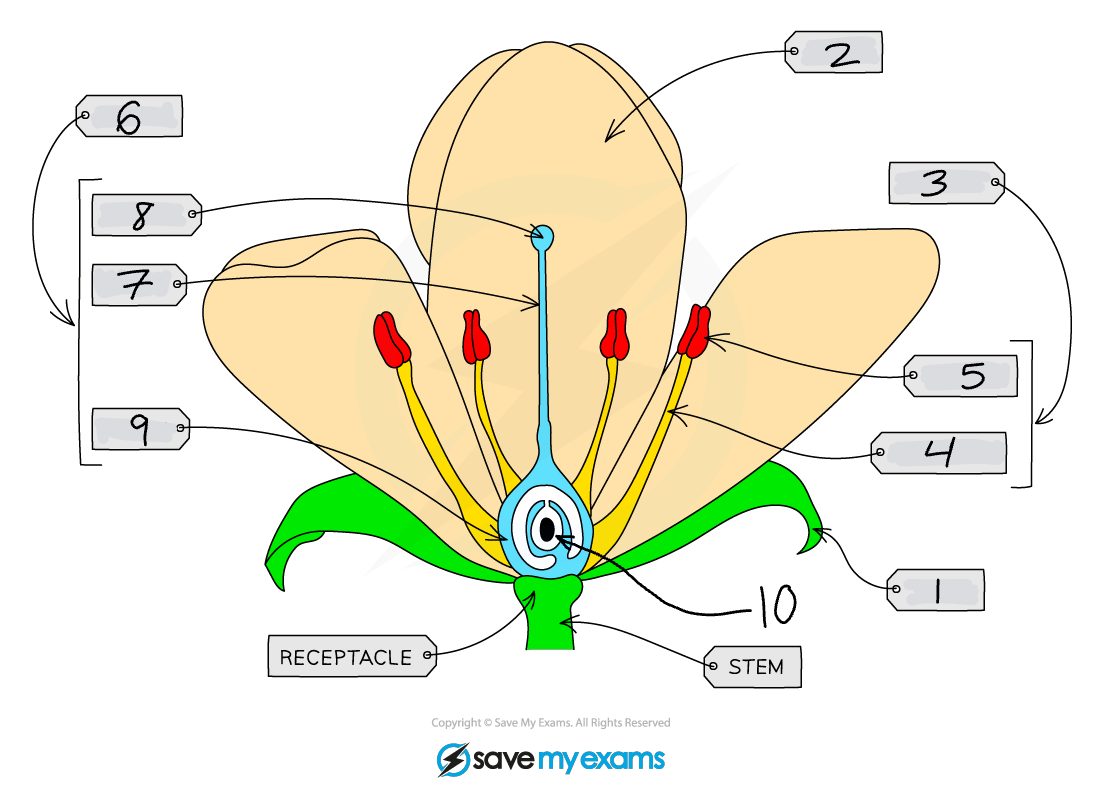
What is 10?
Ovules
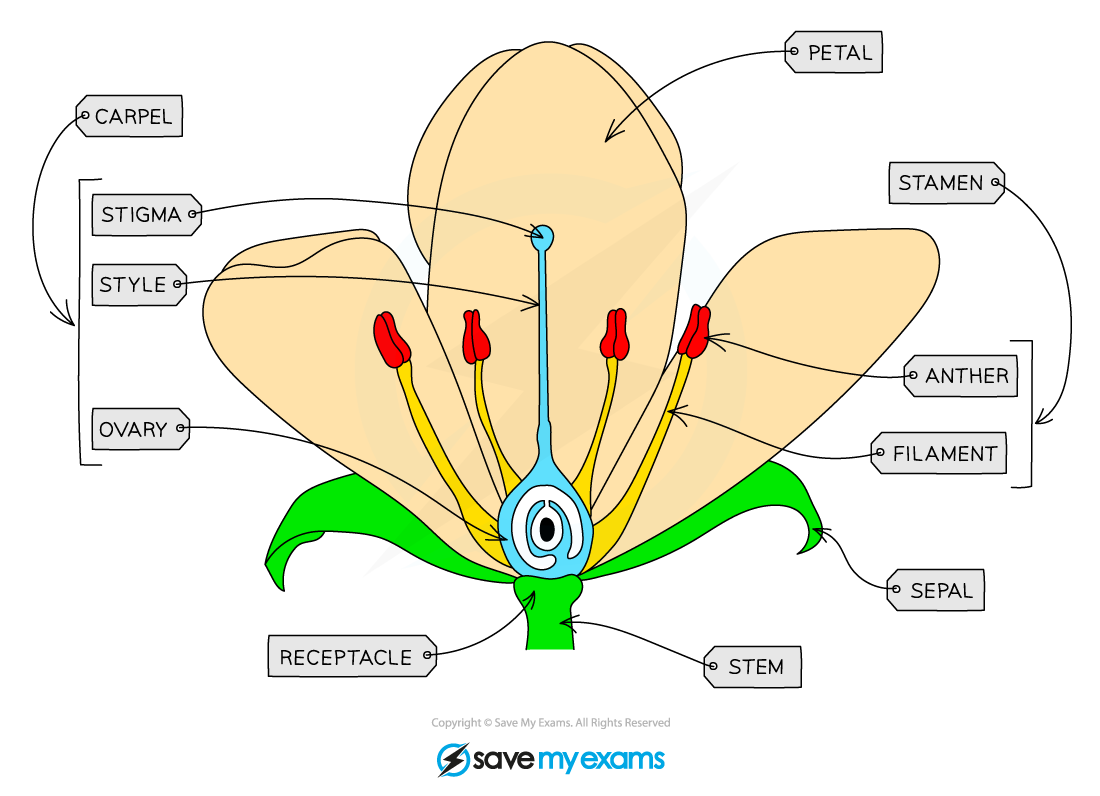
What is the function of the sepal?
It protects the unopened flower.
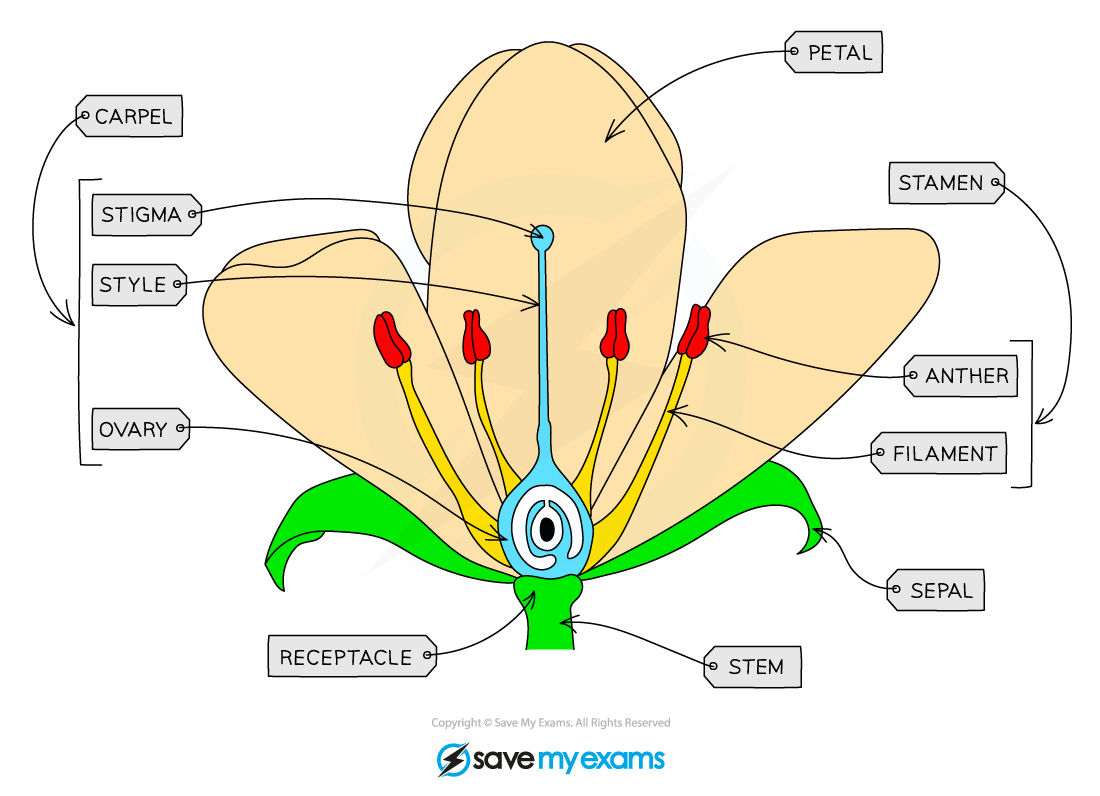
What is the function of the petals?
They are brightly colored in insect-pollinated flowers to attract insects.
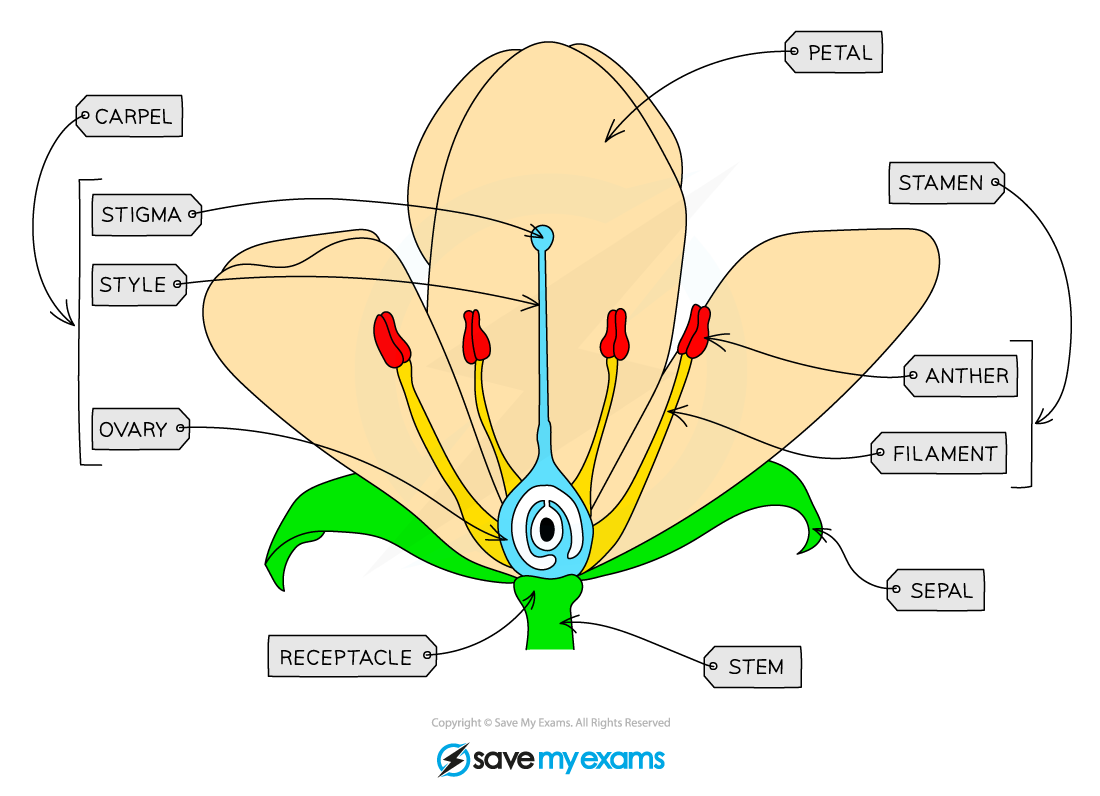
What is the function of the anther?
They produce and release pollen.
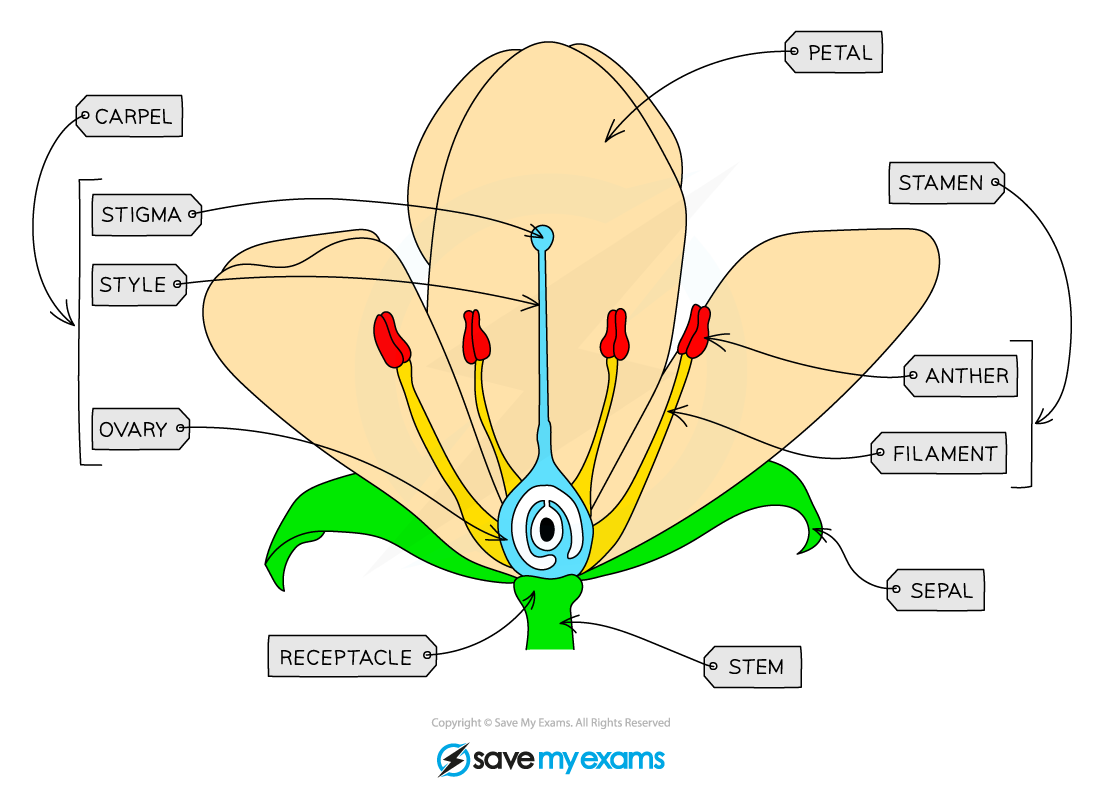
What is the function of the filaments?
They provide support to the anther.

What is the function of the stigma?
It is the sticky top of the female part of the flower which collects pollen grains.
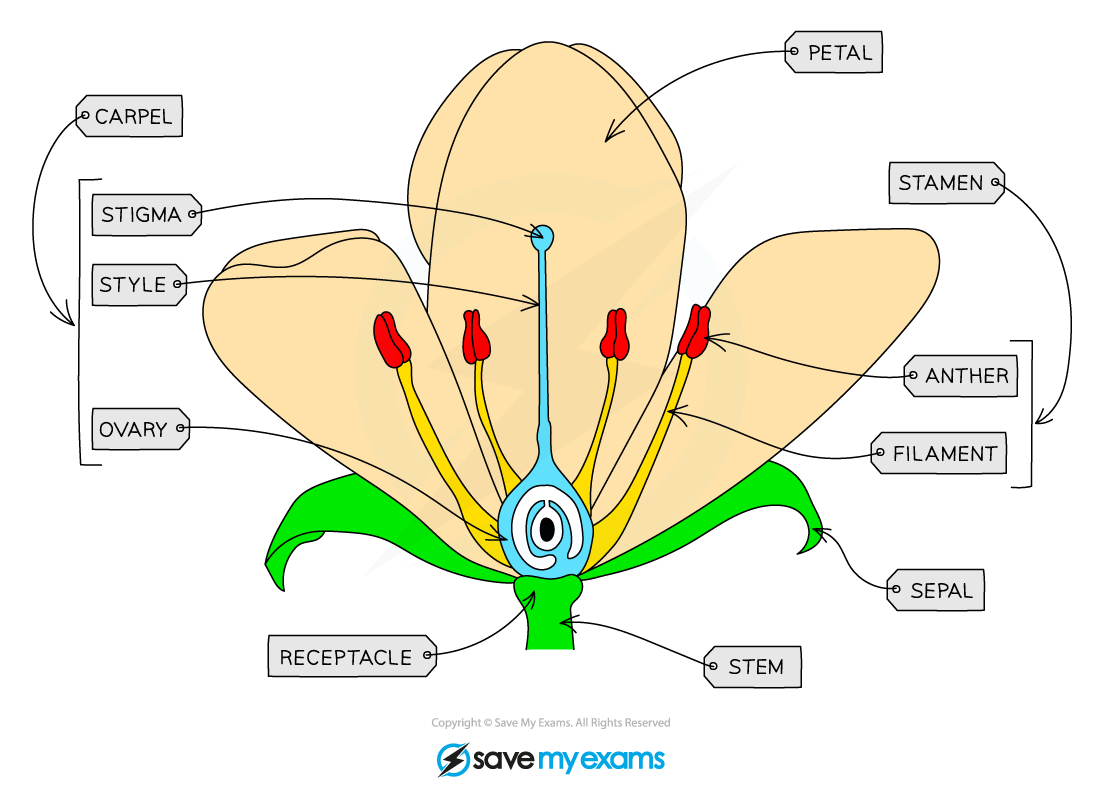
What is the function of the style?
It is a tube that connects the stigma and ovary.
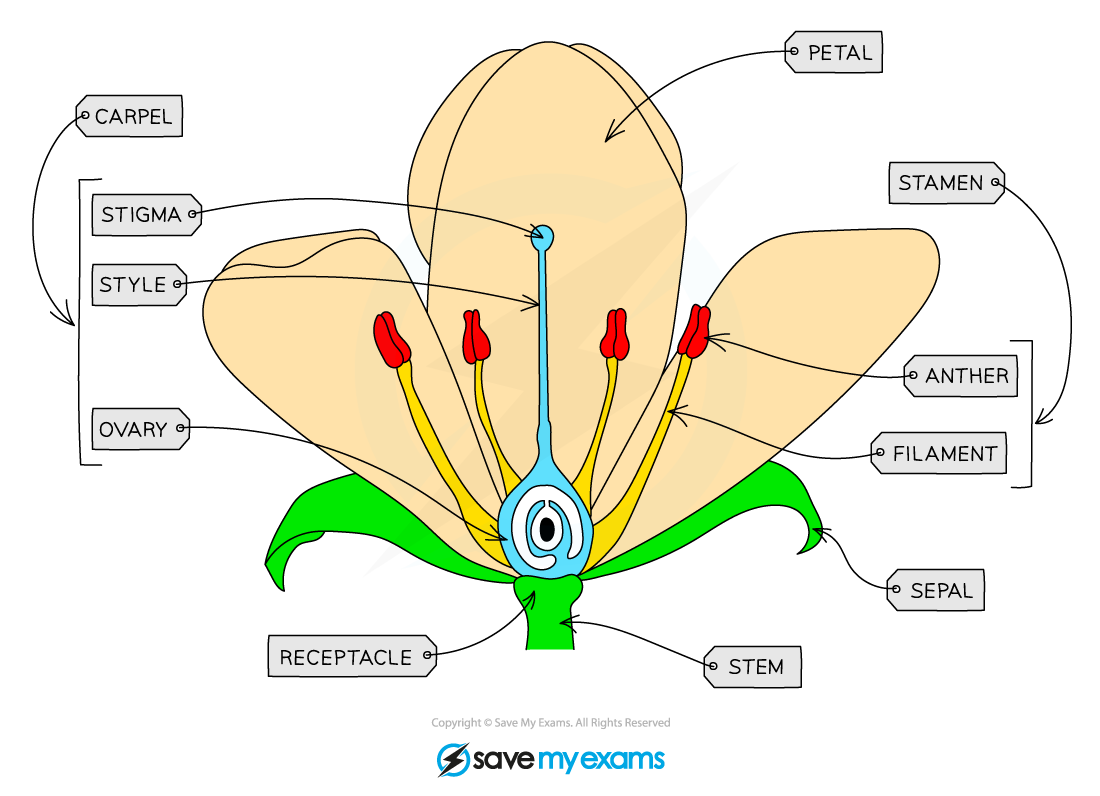
What is the function of the ovary?
It contains the ovules.
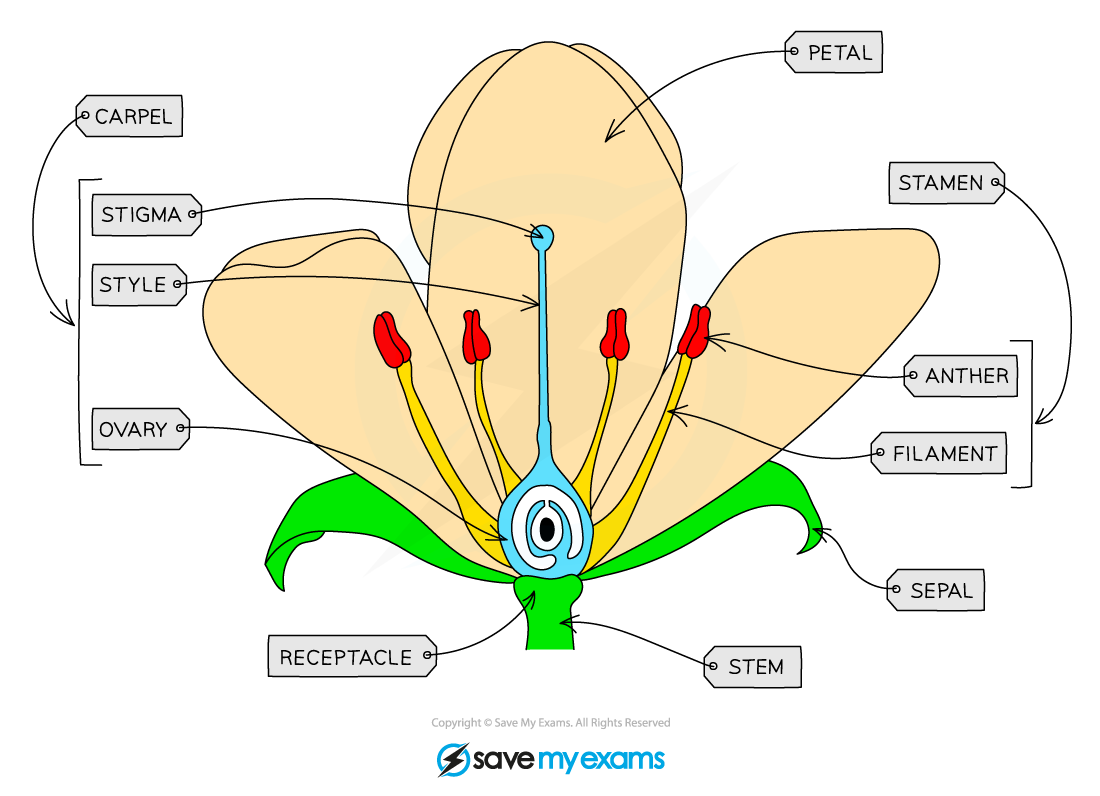
What is the function of the ovule?
It is a structure inside the ovary that contains the female gametes.
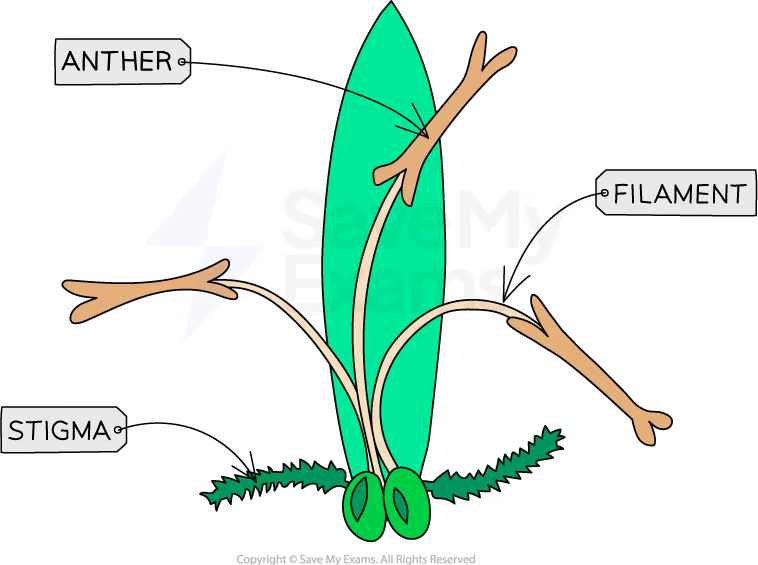
How are the anthers and stigmas of a wind-pollinated flower adapted to increase the chance of successful pollination?
The anthers and stigmas of wind pollinated flowers hang outside the flower so that pollen can easily be blown away by the wind & can easily be caught by the stigmas of other flowers.
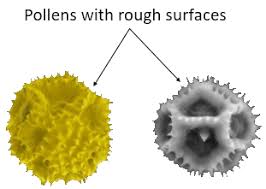
What do the pollen grains of an insect-pollinated flower look like?
They are larger and heavier and often contain spikes or hooks on the outside so that they are able to stick on better to insects.
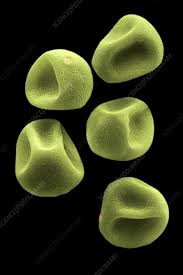
What do the pollen grains of an wind-pollinated flower look like?
They are small and lightweight that can be caught and carried easily by the wind.
What is pollination?
The transfer of pollen grains from an anther to a stigma.
What is self-pollination?
The transfer of pollen grains from the anther of a flower to the stigma of the same flower, or a different flower on the same plant.
What is cross-pollination?
The transfer of pollen grains from the anther of a flower to the stigma of a flower on a different plant of the same species.
What is the effect of self pollination on genetic variation and a population’s ability to adapt to environmental changes?
Low genetic variation because offspring receive genes from one parent, reducing the population’s ability to adapt to environmental changes as it is less likely that any offspring will have the adaptations to suit the new conditions well.
They are less reliant on pollinators as reproduction can still happen even if pollinators are scarce. This can lead to inbreeding and accumulation of harmful genes over time.
What is the effect of cross pollination on genetic variation and a population’s ability to adapt to environmental changes?
It produces high genetic variation because genes come from two parents, increases the population’s capacity to respond to changes like disease or climate shifts as it is more likely that any offspring will have the adaptations to suit those new conditions well.
They rely heavily on pollinators (e.g. insects, wind), so if pollinators are absent, reproduction may be reduced. This helps maintain a healthier gene pool and improves survival chances in changing environments.
How does fertilization occur?
When a pollen nucleus fuses with a nucleus in an ovule.
What structural adaptations does the petal of an insect pollinated flower have?
They are large and brightly colored to attract insects.
What structural adaptations does the scent and nectar of an insect pollinated flower have?
The scent and nectar are produced to encourage insects to visit the flower and push past stamen to get to nectar.
What structural adaptations does the anthers of an insect pollinated flower have?
They hold onto stiff filaments within the flower so that they can brush against insects.
What structural adaptations does the stigma of an insect pollinated flower have?
They are sticky so that they are able to catch pollen grains within the flower when insects brush past.
What structural adaptations does the petals of a wind pollinated flower have?
They are small and dull, often green or brown in colour
What structural adaptations does the scent & nectar of a wind pollinated flower have?
They are are not produced as it would be a waste of energy.
What structural adaptations do the anthers of a wind pollinated flower have?
They hold on to long filaments outside the flower to release pollen grains easily into the wind.
What structural adaptations do the stigma of a wind pollinated flower have?
They are feathery so that they can catch airborne pollen grains.
How does fertilisation occur in flowering plants, starting from the growth of the pollen tube to the fusion of nuclei?
A pollen tube grows from the pollen grain down the style until it reaches the ovary.
Nuclei from pollen travel down the tube.
The nuclei enter the ovule and fuse with the nucleus of the female gamete (fertilisation).
After fertilisation the ovules develop into seeds and the ovary develops into a fruit.
Germination is the start of growth in the seed. What are the 3 environmental factors needed for a seed to germinate?
Water, Oxygen, & Warmth/Suitable Temperature
Why is water needed for successful germination?
It allows the seed to swell up and the enzymes in the embryo to start working so that growth can occur.
Why is oxygen needed for successful germination?
So that energy can be released for germination.
Why is warmth/suitable temperature needed for successful germination?
Germination improves as temperature rises (up to a maximum) as the reactions which take place are controlled by enzymes.